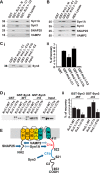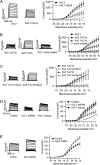Kv2.1 clusters on β-cell plasma membrane act as reservoirs that replenish pools of newcomer insulin granule through their interaction with syntaxin-3
- PMID: 29549124
- PMCID: PMC5936832
- DOI: 10.1074/jbc.RA118.002703
Kv2.1 clusters on β-cell plasma membrane act as reservoirs that replenish pools of newcomer insulin granule through their interaction with syntaxin-3
Abstract
The voltage-dependent K+ (Kv) channel Kv2.1 is a major delayed rectifier in many secretory cells, including pancreatic β cells. In addition, Kv2.1 has a direct role in exocytosis at an undefined step, involving SNARE proteins, that is independent of its ion-conducting pore function. Here, we elucidated the precise step in exocytosis. We previously reported that syntaxin-3 (Syn-3) is the key syntaxin that mediates exocytosis of newcomer secretory granules that spend minimal residence time on the plasma membrane before fusion. Using high-resolution total internal reflection fluorescence microscopy, we now show that Kv2.1 forms reservoir clusters on the β-cell plasma membrane and binds Syn-3 via its C-terminal C1b domain, which recruits newcomer insulin secretory granules into this large reservoir. Upon glucose stimulation, secretory granules were released from this reservoir to replenish the pool of newcomer secretory granules for subsequent fusion, occurring just adjacent to the plasma membrane Kv2.1 clusters. C1b deletion blocked the aforementioned Kv2.1-Syn-3-mediated events and reduced fusion of newcomer secretory granules. These insights have therapeutic implications, as Kv2.1 overexpression in type-2 diabetes rat islets restored biphasic insulin secretion.
Keywords: Kv2.1; insulin secretion; newcomer insulin granule; pancreatic islet; plasma membrane; potassium channel; syntaxin-3; vesicles.
© 2018 Greitzer-Antes et al.
Conflict of interest statement
The authors declare that they have no conflicts of interest with the contents of this article
Figures






Similar articles
-
Kv2.1 Clustering Contributes to Insulin Exocytosis and Rescues Human β-Cell Dysfunction.Diabetes. 2017 Jul;66(7):1890-1900. doi: 10.2337/db16-1170. Epub 2017 Jun 12. Diabetes. 2017. PMID: 28607108 Free PMC article.
-
Syntaxin-4 mediates exocytosis of pre-docked and newcomer insulin granules underlying biphasic glucose-stimulated insulin secretion in human pancreatic beta cells.Diabetologia. 2015 Jun;58(6):1250-9. doi: 10.1007/s00125-015-3545-4. Epub 2015 Mar 13. Diabetologia. 2015. PMID: 25762204
-
Syntaxin 2 Acts as Inhibitory SNARE for Insulin Granule Exocytosis.Diabetes. 2017 Apr;66(4):948-959. doi: 10.2337/db16-0636. Epub 2017 Jan 23. Diabetes. 2017. PMID: 28115395 Free PMC article.
-
Recent new insights into the role of SNARE and associated proteins in insulin granule exocytosis.Diabetes Obes Metab. 2017 Sep;19 Suppl 1:115-123. doi: 10.1111/dom.13001. Diabetes Obes Metab. 2017. PMID: 28880475 Review.
-
Here come the newcomer granules, better late than never.Trends Endocrinol Metab. 2014 Aug;25(8):381-8. doi: 10.1016/j.tem.2014.03.005. Epub 2014 Apr 16. Trends Endocrinol Metab. 2014. PMID: 24746186 Review.
Cited by
-
Kv2 channels create endoplasmic reticulum / plasma membrane junctions: a brief history of Kv2 channel subcellular localization.Channels (Austin). 2019 Dec;13(1):88-101. doi: 10.1080/19336950.2019.1568824. Channels (Austin). 2019. PMID: 30712450 Free PMC article. Review.
-
Activity-dependent endoplasmic reticulum Ca2+ uptake depends on Kv2.1-mediated endoplasmic reticulum/plasma membrane junctions to promote synaptic transmission.Proc Natl Acad Sci U S A. 2022 Jul 26;119(30):e2117135119. doi: 10.1073/pnas.2117135119. Epub 2022 Jul 21. Proc Natl Acad Sci U S A. 2022. PMID: 35862456 Free PMC article.
-
Hypertonicity during a rapid rise in D-glucose mediates first-phase insulin secretion.Front Endocrinol (Lausanne). 2024 Jun 26;15:1395028. doi: 10.3389/fendo.2024.1395028. eCollection 2024. Front Endocrinol (Lausanne). 2024. PMID: 38989001 Free PMC article.
-
Celebrities in the heart, strangers in the pancreatic beta cell: Voltage-gated potassium channels Kv 7.1 and Kv 11.1 bridge long QT syndrome with hyperinsulinaemia as well as type 2 diabetes.Acta Physiol (Oxf). 2022 Mar;234(3):e13781. doi: 10.1111/apha.13781. Epub 2022 Jan 22. Acta Physiol (Oxf). 2022. PMID: 34990074 Free PMC article. Review.
-
A glucose-dependent spatial patterning of exocytosis in human β-cells is disrupted in type 2 diabetes.JCI Insight. 2019 May 14;5(12):e127896. doi: 10.1172/jci.insight.127896. JCI Insight. 2019. PMID: 31085831 Free PMC article.
References
-
- MacDonald P. E., Sewing S., Wang J., Joseph J. W., Smukler S. R., Sakellaropoulos G., Wang J., Saleh M. C., Chan C. B., Tsushima R. G., Salapatek A. M., and Wheeler M. B. (2002) Inhibition of Kv2.1 voltage-dependent K+ channels in pancreatic beta-cells enhances glucose-dependent insulin secretion. J. Biol. Chem. 277, 44938–44945 10.1074/jbc.M205532200 - DOI - PubMed
-
- Singer-Lahat D., Sheinin A., Chikvashvili D., Tsuk S., Greitzer D., Friedrich R., Feinshreiber L., Ashery U., Benveniste M., Levitan E. S., and Lotan I. (2007) K+ channel facilitation of exocytosis by dynamic interaction with syntaxin. J. Neurosci. 27, 1651–1658 10.1523/JNEUROSCI.4006-06.2007 - DOI - PMC - PubMed
-
- Feinshreiber L., Singer-Lahat D., Friedrich R., Matti U., Sheinin A., Yizhar O., Nachman R., Chikvashvili D., Rettig J., Ashery U., and Lotan I. (2010) Non-conducting function of the Kv2.1 channel enables it to recruit vesicles for release in neuroendocrine and nerve cells. J. Cell Sci. 123, 1940–1947 10.1242/jcs.063719 - DOI - PubMed
Publication types
MeSH terms
Substances
Grants and funding
LinkOut - more resources
Full Text Sources
Other Literature Sources
Medical
Molecular Biology Databases
Miscellaneous

